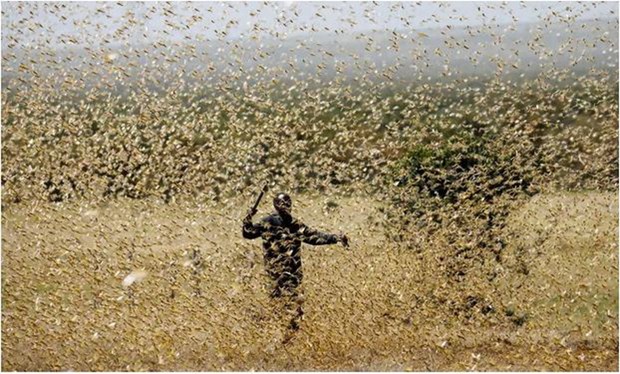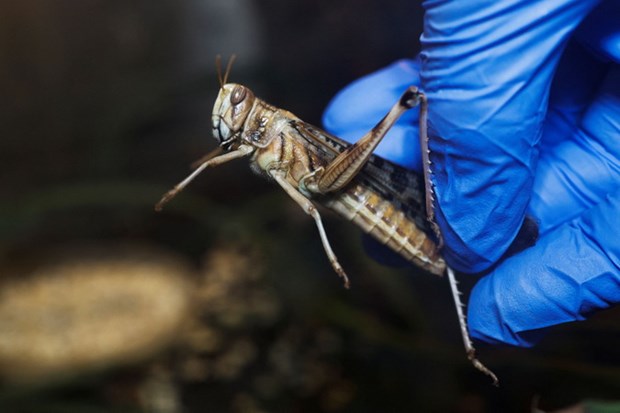Scientists have discovered a locust pheromone that could help them find a way to control the voracious insects that threaten the food security of millions of people across Asia and Africa.
 |
| A farmer tries to fight off a swarm of locusts on a farm near Nanyuki town, Laikipia county, Kenya. Source: Reuters |
Scientists have just discovered a type of pheromone (a chemical secreted from the body that acts as a communication between individuals of the same species) of locusts, which helps this species avoid being eaten by its own kind in swarm life.
The discovery paves the way for finding effective methods to control the voracious insects that threaten the food security of millions of people across Asia and Africa.
The results of the study were published in Science Magazine on May 4.
The behavior of locust swarms is driven not by coordination between individuals but by the fear of being eaten by their own kind, said study leader Bill Hansson, head of the Department of Evolutionary Neurobiology at Germany's Max Planck Institute.
In fact, cannibalism is common in the natural world , such as lions killing and eating their own cubs or foxes eating the carcasses of their own kind. In the case of locusts, cannibalism is thought to maintain ecological balance among them.
The migratory locust (locusta migratoria) comes in many different forms and behaves very differently from regular locusts. For the most part, this species of locust is “solitary” and eats relatively little, like the “shy” locusts.
However, as their population increases and food becomes scarce, they begin to produce hormones that alter their behavior, causing them to flock together and become more aggressive.
According to a 2020 study by Iain Couzin of the Max Planck Institute for Zoology, this process is called the “swarming” phase and the fear of being eaten by other locusts causes the entire swarm to move in the same direction toward areas with more food.
“Locusts eat each other from behind,” explains Hansson. So if they stop moving, they will be eaten by others, which leads the team to think that most animals have some kind of countermeasure when threatened.
In a series of experiments conducted over four years, Hansson's team of researchers first determined that cannibalism rates actually increased in proportion to the number of swarming locusts housed in the same cage.
 |
| A scientist researched and discovered a type of locust pheromone that helps this species avoid being eaten by other species in swarm life. (Source: Reuters) |
Locusts began to eat each other when the number of locusts in a cage exceeded 50. Next, they compared the odors emitted by solitary and swarming locusts, finding 17 unique chemicals that were only released when the locusts were in a swarm. Among these was phenylacetonitrile (PAN), which repels other locusts.
PAN is involved in the synthesis of a potent toxin called hydrogen cyanide that is sometimes secreted by migratory locusts, so its release seems consistent with its role as a signal telling others to back off.
To confirm the new discovery, scientists used the CRISPR method to edit locust genes, making them unable to produce PAN anymore and thereby making them susceptible to cannibalism.
In addition, scientists tested dozens of locust olfactory receptors (which sense odors) and found one that was highly sensitive to PAN. When they genetically modified locusts so that they no longer produced this receptor, they became more likely to eat their own kind.
The new findings shed light on the “complex balance” between the mechanisms that cause migrating locusts to swarm rather than compete with each other, the scientists said. Future locust control methods could therefore use technology that helps tip the delicate balance toward more competition.
The ultimate goal is that instead of killing migratory locusts, control methods could help shrink swarms, directing them to areas where humans do not farm.
( According to https://www.vietnamplus.vn/ap-dung-cong-nghe-de-xu-ly-dich-chau-chau-pha-hoai-mua-mang/860835.vnp )
.
Source link































































































Comment (0)